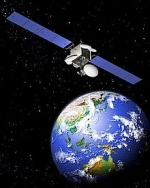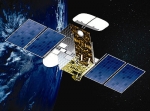Displaying items by tag: communications satellite
MEASAT 3
MEASAT-3 is a communications satellite operated by the Malaysian company MEASAT Satellite Systems Sdn. Bhd.
It was successfully launched on December 12, 2006, 7.35 am (Malaysian Time, GMT +8.00 HRS) from the Baikonur Cosmodrome, Kazakhstan.
In March 2003, MEASAT Satellite Systems Sdn. Bhd. of Malaysia ordered a Boeing 601HP satellite, giving it the designation MEASAT-3 at that time. MEASAT-3 joined the existing Boeing-built MEASAT-1 and MEASAT-2 spacecraft in the Malaysia-East Asia Satellite (MEASAT) system.
International Launch Services (ILS) was contracted as the launch provider. Boeing was specified to also provide an upgrade to the MEASAT ground facilities in Malaysia, as well as training and launch support services.
Loral Space & Communications Inc.
Loral Space & Communications Inc. is a satellite communications company. The company was formed in 1996 from the remnants of Loral Corporation when Loral divested its defense electronics and system integration businesses to Lockheed Martin.
Loral has an investment in Telesat Canada in partnership with the Public Pension Investment Board of Canada. The company also participates in a number of international and domestic joint ventures, including an ownership stake in XTAR.
In Nov. 2012, Loral Space & Communications Inc. sold its manufaturing subsidiary SS/L to MDA.
see: "Loral closes sale of Space Systems/Loral to MDA" (Press release - 2 November 2012)
ORBCOMM Inc.
ORBCOMM Inc. is a company that offers machine to machine (M2M) global asset monitoring and messaging services from its constellation of 29 Low-Earth-Orbit (LEO) communications satellites orbiting at 775 km.
Like its voice-centric competitors Iridium and Globalstar, it filed for Chapter 11 protection, in September, 2000. ORBCOMM issued a public offering of stock in November 2006. The company sold 9.23 million shares of common stock.
ORBCOMM provides satellite data services. ORBCOMM has control centers in the United States, Brazil, Japan, and Korea, as well as U.S. ground stations in New York, Georgia, Arizona, and Washington State, and international ground stations in Curaçao, Italy, Australia, Kazakhstan, Brazil, Argentina, Morocco, Japan, Korea, and Malaysia. Plans for additional ground station locations are under way.
ORBCOMM is offering services for users who send very small amounts of data. To avoid interference, terminals are not permitted to be active more than 1% of the time, and thus they may only execute a 450ms data burst twice every 15 minutes. The latency inherent in Orbcomm’s network design prevents it from supporting certain safety-critical applications.
Orbcomm's direct competition includes Globalstar’s simplex services and L-band leased capacity services such as those offered by SkyBitz. Orbcomm's most significant competitor, however, is Iridium, which offers the lower latency and more capable Iridium SBD service which can send larger data packets with lower latency and a much smaller antenna.
ORBCOMM services are much like email and messages.
MEASAT Satellite Systems Sdn.
MEASAT Satellite Systems Sdn. Bhd., formerly Binariang Satellite Systems Sdn. Bhd is a Malaysian communications satellite operator, which owns and operates the MEASAT (Malaysia East Asia Satellite) spacecraft.
As of 2006, the MEASAT satellite network consists of three geostationary satellites designed and built by Boeing Satellite Systems. MEASAT-1 and MEASAT-2 were launched in 1996 and MEASAT-3 in 2006.
HYLAS-1
HYLAS (or HYLAS-1) is a British satellite in geostationary orbit.
HYLAS-1, which is an acronym for Highly Adaptable Satellite, is a communications satellite and was launched by the European Ariane 5 launch vehicle from the Guyana Space Centre at Kourou in French Guyana.
It is located at the orbital location of 33.5 degrees west and will provide communications services including High Definition Television (HDTV) and interactive satellite delivered broadband services.
The Hylas satellite operator is Avanti Communications.
Intelsat 28 / New Dawn
Intelsat 28, formerly New Dawn, is a communications satellite produced and run by Intelsat. It is positioned in geosynchronous orbit at 33 degrees east and serving TV and broadband communications to Africa.
It is based around the STAR-2 satellite platform.
PanAmSat
The former PanAmSat Corporation founded in 1984 by Reynold (Rene) Anselmo, was a satellite service provider headquartered in Greenwich, Connecticut. It operated a fleet ofcommunications satellites used by the entertainment industry, news agencies, internet service providers, government agencies, and telecommunication companies. Anselmo got the idea for PanAmSat from Martine Rothblatt, an independent communications lawyer in Washington, D.C., to whom he had turned to for advice regarding difficulties he was encountering in getting reasonably priced satellite transmission of his UHF-TV based Spanish International Network (SIN), with studios on 42nd Street in New York City. Rothblatt had written a business plan entitled PanAmSat for her MBA thesis at UCLA's Graduate School of Management and was seeking a financial backer. Anselmo partnered with Rothblatt on the PanAmSat project, with Anselmo providing financing and Rothblatt filing for approval from the Federal Communications Commission and lining up an initial satellite from RCA Astro-Electronics and a heavily discounted launch from Arianespace.
PanAmSat effectively broke the monopoly on international satellite communications which was held by Intelsat, an international treaty-based organization founded and owned by several countries including the United States. PanAmSat, led by Anselmo, successfully lobbied the United States Congress to permit it to operate globally, competing against Intelsat. PanAmSat (and Anselmo) became famous for full-page advertisements in the Wall Street Journal depicting Spot, the PanAmSat mascot, urinating on politicians' legs. The company's motto was "Truth and Technology Will Triumph Over Bullshit and Bureaucracy."
Following the death of Rene Anselmo in 1995,[1] his widow Mary Anselmo controlled the company for a time. PanAmSat was sold to Hughes Electronics, a division of General Motors, in a $3 billion cash and stock deal. The satellite operations continued to be under PanAmSat with Hughes being the majority shareholder. In May 1997, Hughes Communication Galaxy merged with PanAmSat, adding 9 more satellites to its fleet. In 2003, News Corporation purchased Hughes Electronic's PanAmSat division and on April 24, 2004 sold PanAmSat to a consortium ofprivate equity firms in an leveraged buyout including Kohlberg Kravis Roberts & Co. (KKR), Carlyle Group and Providence Equity Partners for $4.3 billion.






